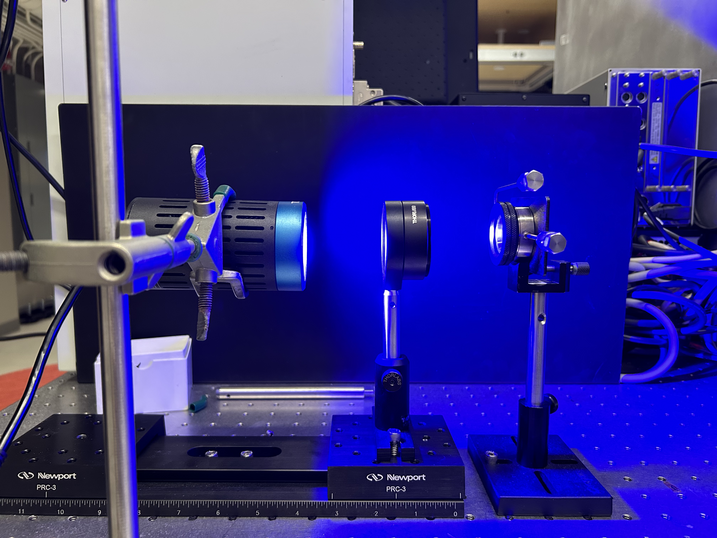Silver Linings
Scientific breakthrough could lower costs, raise sustainability, and open new vistas in chemistry
Fluorine is an important component in many pharmaceuticals—including drugs like Prozac and Celexa, which have become first-line treatments for anxiety and depression. There's a significant concern with fluorination, though: it's expensive. Reagents used to install the trifluoromethyl (CF₃) group, found in many drugs, can cost tens of thousands of dollars per kilogram. The reason is that organic fluorides aren't often found in nature, so manufacturers must rely on synthetic methods.
But what if there were a way to use a much cheaper compound—one similar in composition to common household vinegar—to install CF₃ in life-saving pharmaceuticals? And what if the process were not only cheaper but also more energy efficient and thus environmentally sustainable?
Thanks to “All that Glitters Is Not Gold,” the 2025 Harvard Horizons project of chemistry PhD student Brandon Campbell, a better method of fluorination may be more than just wishful thinking. Using silver and visible light, Campbell is pioneering a new method of CF₃ incorporation—one that, if brought to scale, could be both more cost-effective and easier on the climate.
Light Reaction
A potential alternative to synthetic CF₃ precursors is trifluoroacetate (TFA), a compound closely related to vinegar. TFA is extremely cheap. Unfortunately, it is also extremely stable. The process of liberating the fluorine atoms in TFA and synthesizing them with other compounds currently requires a lot of energy.
“With a super-expensive synthetic CF₃ source, you can basically look at it funny, and it'll spit off its fluorine atoms,” Campbell says. “For TFA, you have to either heat it to high temperatures, use high-energy ultraviolet (UV) photolysis, or hook it up to intense voltages. Under those conditions, the molecule you're trying to put fluorine atoms onto often degrades itself.”

Campbell wanted to create a process strong enough to activate TFA but mild enough to preserve the molecule that a chemist wants to fluorinate. For a solution, he looked to a process called photoredox, which uses light to trigger chemical reactions and make molecules. Photoredox relies on a photocatalyst to absorb and harness light and then use it productively in a given chemical reaction. The challenge for Campbell was that no traditional photocatalysts were able to use light to activate TFA.
“Think about these processes in terms of excited-state redox potentials [the ability of a photocatalyst, when it absorbs light, to induce redox],” he explains. “Common photocatalysts can only get up to about 1.7 volts or so of oxidizing power with light absorption. But you need more than 2.2 or 2.4 volts to activate TFA. So, there's a mismatch in accessible energies with traditional photocatalysts.”
Common photocatalysts can only get up to about 1.7 volts or so of oxidizing power with light absorption. But you need more than 2.2 or 2.4 volts to activate TFA. So, there's a mismatch in accessible energies with traditional photocatalysts.
—Brandon Campbell
Shedding Light on Silver
Campbell’s breakthrough was using silver, enabling the fluorination process to take place using only low-energy light.
Most people are familiar with silver in its unoxidized state, for instance, in coins or jewelry. Silver in its first oxidation state, silver 1+, is a very common salt of silver—the silver nitrate doctors use to cauterize a bloody nose or the silver bromide used in the first cameras. Campbell uses the element in its second oxidation state—silver 2+, which is rarely employed in chemistry because it is so unstable. But when it comes to activating TFA, this drawback becomes a big advantage.
“I reasoned that if I could make silver 2+ and stabilize it enough, I could make a silver 2+-TFA bond and then activate it through a process called ligand-to-metal charge transfer,” he says. “I take an electron from my ligand, which is TFA, and move it to my metal, which is silver. For ligand-to-metal charge transfer to work for TFA, you need a metal that is really hungry for an electron. We settled on silver 2+ precisely because of its instability.”
The charge transfer process could then be activated with low-energy light, one of Campbell’s goals for the process. “Visible light is less harsh and more chemoselective—that is, absorbed only by a photocatalyst, as opposed to UV light, which would be absorbed by other elements in a reaction mixture,” Campbell explains.

Usually, using visible light in the catalytic process would be a barrier, but using silver 2+ and TFA makes it possible. “If you excite the silver 2+-TFA ensemble with visible light, you get a movement of charge density from your TFA molecule to your silver center,” Campbell says. “It's as if, when I'm shining light on it, I'm generating silver 1+, and in the process, oxidizing TFA to a radical.”
The light, in effect, cleaves the stable silver 1+ molecule from the unstable TFA radical, which undergoes a process called decarboxylation, releasing carbon dioxide and yielding a CF₃ radical. Also unstable, the CF₃ radical immediately reacts with the small molecules in the solution, creating the fluorinated compound.
“Let's say I wanted to make trifluoromethylbenzene from benzene,” Campbell explains. “I have benzene in my solution with my silver 2+ and my TFA. The silver 2+ binds to the TFA. I shine light on it. It releases silver 1+, CO₂, and CF₃ radicals. Those CF₃ radicals then find benzene and add to it to make trifluoromethylbenzene. Now I have my trifluoromethylated product.”
The Coolest Thing
Although there may be financial benefits to activating TFA, a cheap source of fluorine, Campbell says that the ability to conduct fluorination with silver photocatalysts could have a wide-ranging impact on chemistry. “TFA is one of the hardest things I can think of about oxidizing,” he says. “It stands to reason that if we can oxidize that, then we can oxidize basically anything. As long as it can bind to silver, we can oxidize it.”
Professor Daniel Nocera, Campbell’s advisor, agrees. “Beyond sustainable manufacturing, Brandon’s work opens the door to reactions where there is no reagent capable of performing the transformation, sustainable or not,” he says. “Work will soon be coming out that generalizes the reaction to enable others for which no reagent is known. Also, there is an issue of post-synthetic modification of a substrate, which offers flexibility in drug design.”
Brandon’s work opens the door to reactions where there is no reagent capable of performing the transformation.
—Professor Daniel Nocera
The breakthrough of which Campbell is most proud, perhaps, is the use of low-energy visible light. That’s because his original intent in joining Nocera’s lab was to conduct research related to climate change, including clean energy technology and solutions. In the process, he discovered a passion for photochemistry and molecular synthesis. But he still hopes his work can have an impact on our warming planet.
“A lot of existing photoredox methods are extremely inefficient and not sustainable because they shine millions of photons at something to get one molecule out,” he says. “So, while the work enabled the use of trifluoroacetate for these CF₃ trifluoromethylation reactions, which are important for drugs, the real advance is that it’s able to activate it at high efficiencies with visible light, like blue or green or orange light, which is really low energy and hasn't been done. That’s the coolest thing about it.”
Get the Latest Updates
Join Our Newsletter
Subscribe to Colloquy Podcast
Simplecast




